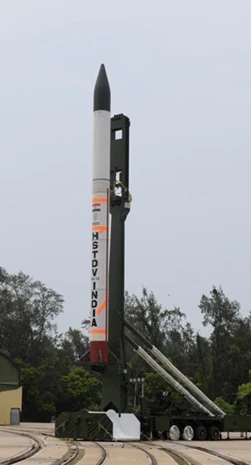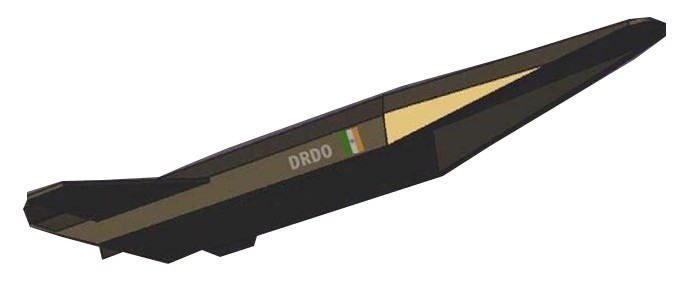Scientists from the Northwestern Polytechnic University in Xi’an reported on the successful test flight of a hypersonic transport rocket this month, which combined the characteristics of rocket and ‘breathing’ hypersonic engines, providing flight in a different speed range, including more than Mach 5. According to the Chinese edition of SCMP, the work on the project was not hindered by the fact that the University has long been under U.S. sanctions.
The University said the test flight was a “complete success” and was the world’s first proof-of-work for critical new technologies. The air-breathing engine used inexpensive and relatively clean rocket fuel – Kerosene. The launch took place at an unspecified test site in the northwestern region of China. The rocket launched from a vertical position and demonstrated both engines’ smooth and consistent launch – the auxiliary rocket and the main hypersonic.
A supersonic flight is considered hypersonic if it crosses Mach 5.
At the time of launch, both engines of the Feitian-1 test vehicle were working simultaneously. The rocket engine shutdown occurred after the rocket went into supersonic mode. The ‘breathing’ hypersonic engine used outboard oxygen for the flight, saving on the supply of onboard fuel.

Problems began when accelerating to Mach 4 – the air mixture ceased to flow into the engines in sufficient volume, but in this case, another system for mixing components was provided — switching to the second circuit allowed accelerating the test vehicle to a higher speed.
Scientists note that another problem was organizing the transitions between different engine modes on Kerosene. Kerosene is not as active a fuel as hydrogen, and the processes for its controlled ignition have added work for scientists. However, the flight showed that the scientists coped with their work. The tests confirmed “a breakthrough in some critical technologies, such as heat flow control and highly efficient combustion [of fuel] over an ultra-wide speed range.”
The rocket is assumed to operate on the ‘waverider design’, which generates lift from the shockwaves produced when flying at higher supersonic speeds.
The different flight speeds mentioned by the University are assumed to be smooth transitions between at least four different propulsion configurations.
Feitian-1 is known to be lighter than existing boost-glide weapons systems like the U.S.Air Force’s AGM-183 ARRW.
This is not the first successful test flight of a Chinese hypersonic vehicle. Successful launches were reported back in 2019 and 2021.
India, too, has tested a scramjet engine
India’s Defense Research and Development Organisation (DRDO) has successfully tested a Supersonic Combustion RAMJET (scramjet) engine with Kerosene as the fuel and air-breathing for producing oxygen.

After failing its maiden flight in 2019, DRDO tested a hypersonic cruise vehicle using a proven solid rocket motor (Agni- 1 missile) this year, that took the Hypersonic Technology Demonstrator Vehicle (HSTDV) to an altitude of 30 km, where its aerodynamic heat shields separated at hypersonic Mach number.
The Agni-I rocket, a short-range ballistic missile, took it to an altitude of 18.6 miles and the hypersonic velocity, as per the statement from the DRDO. The air intake of the scramjet was deployed, and HSDTV continued to fly for more than 20 seconds at a speed of about Mach 6.
Nanqiang No 1 and AVATAR
Both India and China say the intent of developing the scramjet engine is to power their future hypersonic aircraft. China is building the Nanquiang unmanned aircraft, and India is pursuing the Aerobic Vehicle for Hypersonic Aerospace Transportation (AVATAR) project, a DRDO project.
The Nanqiang No 1 UAV weighs about 500kg with three different types of power systems. Nanqiang No 1 uses a high-tech combined cycle engine design known as multi-ducted twin-turbines ejector-ramjet/scramjet, or MUTTER. The multiple power systems include a pair of turbine engines, a small rocket engine and two air-breathing ramjet or scramjet engines. The three engines of different types share a single air inlet.

The full-sized passenger aircraft with a total weight reaching 72 tonnes is designed to take off at Mach 2 with turbine engines, while the relatively small rocket engine would accelerate the aircraft to Mach 4. The sub-ramjet above and the main-ramjet below the aircraft will fire, taking the plane’s speed to above Mach 6. China’s hypersonic projects are secretive, and it is unknown if the scramjet engine from the Feitian-1 vehicle or some other project will be used.
The Chinese aim to finish its test by 2025, leading to the development of a full-sized hypersonic aircraft capable of transporting ten passengers more than 6,000km at Mach 6. The information comes from the project scientist Yin Zeyong’s paper published in Acta Aeronautica et Astronautica Sinica, a peer-reviewed journal published by the China Society of Aeronautics and Astronautics, reports SCMP.
As per DRDO, the AVATAR testbed’s scramjet ramjet engine will be able to reach speeds of Mach 6 – 14 in approximately 2 – 5 km / s. There is ambiguity in the fuel to be used as it could be Kerosene or hydrogen. The Indian Space Research Organisation (ISRO) also has a scramjet program that uses hydrogen. The ISRO Air Breathing Propulsion Project (ABPP) has been tested for 5 seconds.
DRDO has produced a lot of research on the Kerosene Scramjet engine, but Dr Prahlada Ramarao, who was closely associated with the project, told Frontier India that it is a hydrogen-powered engine and hence it can be switched off and on, unlike the rocket engines.
“The advantage of the Indian Supersonic Combustion RAMJET (SCRAMJET) engine is the use of hydrocarbon fuel which is cheap compared to cryogenic fuel used by Israel and Russia. Our engine can be switched off, started and used just like a jet engine instead of a rocket engine type approach. This engine is more sophisticated than a jet engine. The challenge is to take the flight time from 20 seconds to 2 hours. Cooling the engine as well as the aircraft will be the challenge. Before a commercial flight, he told Frontier India that this technology would see military use.

In 2007, a DRDO representative at a two-day international conference on high-speed transatmospheric air and space vehicles, attended by more than 200 specialists from India, Japan, Australia, Russia, Israel and South Africa, said that Kerosene is used in the testing stage of the Scramjet engine project and the final engine would be liquid hydrogen-fuelled. He also said research is underway to create a nickel-cobalt alloy and carbon composite materials that can withstand high temperatures during flight at hypersonic speeds. The hypersonic vehicle program is to create a reusable carrier to reduce the cost of launching spacecraft into orbit. The announcement shows that the AVATAR project is similar to ISRO Reusable Launch Vehicle – Technology Demonstration Program (RLV-TD) or a parallel project. The Indian government does not allow DRDO – ISRO joint projects as sanctions on the military program from the past should not affect ISRO civilian space projects. Like the Northwestern Polytechnic University in Xi’an, many Laboratories of the DRDO are still under U.S. sanctions.
